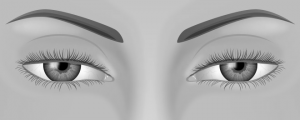Ptosis
What is Eyelid Ptosis?
Ptosis, pronounced “toe-sis” comes from the Greek word to fall. Eyelid ptosis is defined as droopy upper eyelids. When the upper eyelid is lower than normal, it can obstruct the superior field of vision. Patients may feel like a shade, or an awning is covering their eyes. To compensate, patients lift their eyebrows and use their forehead to open their eyes more. This can lead to eye fatigue, especially when driving, reading, or working on the computer. Sometimes, patients lift their eyelids with their finger in order to improve vision. Other patients, especially children with ptosis, lift their chin up in order to see. In addition, children who are born with ptosis in one or both lids may develop a lazy eye, because their vision does not develop properly.

What is the Cause of Ptosis?
There are many causes of ptosis. The most common cause is age related eyelid muscle weakness. Other common causes include congenital ptosis, previous eye surgery, long- term contact lens wear, trauma, or neurologic disorders such as Myasthenia Gravis, Horner’s Syndrome, or Muscular Dystrophy. The main muscle that lifts the eyelid, the levator muscle, can stretch and cause the eyelid to droop. In congenital ptosis, the eyelid muscle is often underdeveloped or replaced with fibrous-fatty tissue resulting in a low eyelid.
Can Ptosis Be Fixed?
Yes. There are several different surgical procedures to improve eyelid ptosis. With the external approach, the stretched levator muscle is tightened and the lid is lifted through an incision in the eyelid skin. These incisions are hidden in the natural lines of the eyelid. If needed, excess skin can also be removed through this incision at the same time. With the external approach, the patient is often asked to “look up” or open their eyes during surgery. This allows the surgeon to assess eyelid height and symmetry intra operatively. Adjustments can be made if necessary.
Another approach, the internal approach, can be performed from underneath the eyelid. The muscles are tightened from the inside of the lid. There is no skin incision with this procedure. In addition, there is no intraoperative assessment.
If there is very little eyelid muscle function, then a sling procedure is needed. A sling is used to couple the eyelid to the forehead muscles, and the forehead helps to lift the lids. Sling materials include silicone or fascial tissue from the patient’s own leg.
The type of procedure chosen depends on each individual patient’s needs. The options and recommendations will be discussed at the time of your consultation.
Both of these procedures are performed on an outpatient basis under twilight anesthesia. They take an hour or less to complete.
What Are Some Complications of Ptosis Surgery?
With most eyelid surgeries, the eyes can feel dry afterward. Usually symptoms are temporary, only lasting for a few weeks. Sometimes they can be permanent. It is difficult to predict who will have this issue. We check the eyes for dryness and inflammation before performing any eyelid surgery. We also evaluate the natural protective mechanisms the eye has against dryness, including eyelid closure.
While every attempt is made during surgery to ensure symmetry between the two eyes, how each patient heals is an unknown variable. Occasionally, a second touch up procedure is needed if the two eyes are not even.





